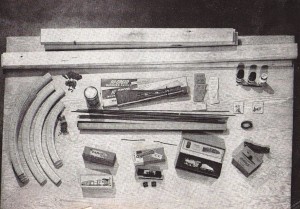The Electroliner traction sets that plied the North Shore between Chicago and Milwaukee were among the best decorated rail cars in the world. There are some great images in an unlikely place here .
.
Archive for August, 2011
Electroliner Images
August 23, 2011The Good Old Days?
August 5, 2011I’m cautiously willing to acknowledge that I grew up in the 1950’s and 1960’s. Leaving aside the old age comments, it is interesting to look back upon the model railroad hobby as it once was and to marvel that this idea ever caught on in the first place. Consider the seasonal project railroad published in the December, 1952 issue of Model Railroader magazine.
The “Pine Tree Central”, which fit onto a flat sheet of 4′ x 6′ plywood with 1×3 pine frame, was designed to start off in the living room at Christmas time. After the Christmas season had passed, it was then supposed to weasel its way into the household, becoming a full-time fixture in some model railroader’s life. Of course, it was the 1950’s, which means that you built everything.
You built everything except the transformer, which is probably just as well; no telling how many houses were not destroyed by fire because of that. It’s interesting looking back at the train:
Once Christmas had passed, the railroad added two more sidings and scenery, and you had something:
Of course, we have progressed considerably since 1952, and the hobby has become much more user friendly. So, too, what you get for your money has improved, too. Consider the 1952 prices and the adjusted-for-inflation 2010 prices:
- Mantua Shifter 0-4-0 steam switcher. $15.95 then, $127.88 now
- Varney gondola. $1.90 then, $15.33 now
- Roundhouse box car. $2.70 then, $21.65 now
- Ulrich stock car. $2.95 then, $23.95 now
- Varney caboose. $2.95 then, $23.95 now
In 2010 dollars, you would have spent $212.06 for items that cost $26.45 back then. And, you still had to spend over 12 hours to build these trains. And, if you were lucky, the 0-4-0 would actually run once you had finished.
Of course, the model train revolution had not really started until the Athearn “Blue Box” trains entered the scene in the late 1950’s. Athearn produced a series of inexpensive yet reliable items that would make a lot of people take up model railroading. Consider these items from the 1971 Walthers catalog:
- Athearn Super Power F-7. $12.95 then, $68.93 now
- Roundhouse gondola. $2.00 then, $10.64 now
- Roundhouse box car. $2.25 then, $11.98 now
- Athearn stock car. $1.98 then, $10.54 now
- Athearn caboose. $2.98 then, $15.86 now
So, in twenty years, the costs for the Pine Tree Central trains had both dropped in dollar cost and improved in quality. By the 1970’s, Walthers no longer sold Mantua, which had been merged into Tyco during that era.
Today, of course, things have become better and cheaper again. This is due, in no small part, to the considerable presence of Chinese labor. Mantua is still in the marketplace, but the smaller engines such as the Shifter are now sold under the Model Power brand. Steam locomotive kits are now an oddity, reserved for those who enjoy a challenge. The Pine Tree Central trains in the modern era:
- Model Power Shifter 0-4-0 steam switcher. $47.98
- Bowser 40′ gondola. $13.95
- Walthers 40′ box car. $19.98
- Accurail stock car. $13.98
- Atlas Trainman caboose. $17.95
And, of course, these different cars are available in a large number of different road names and numbers.
So, 60 years after the Pine Tree Central article was published, the model hobby has grown in both scope and in quality.
A few things have changed along the way. For one, scenery techniques are both more realistic and safer. The 1952 Pine Tree Central article calls for a scenery plaster formula of glue-based patching plaster combined with 7 lbs of ground asbestos. Although this was a widely accepted technique at the time, fortunately, the hobby has become better in any number of ways.
And, we haven’t even talked about the improved locomotive performance that results from command control. I don’t miss the old days; I like to look back and read about them, but I don’t miss them.



